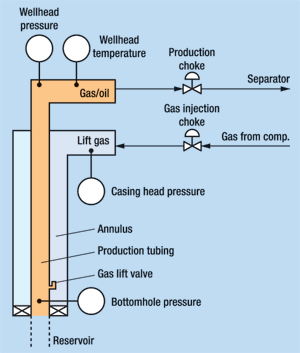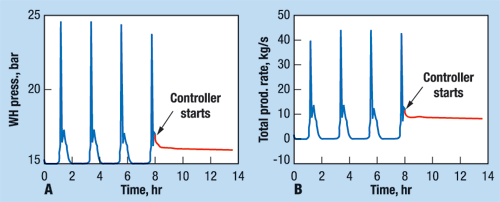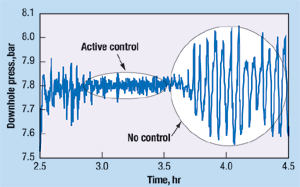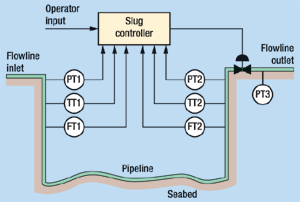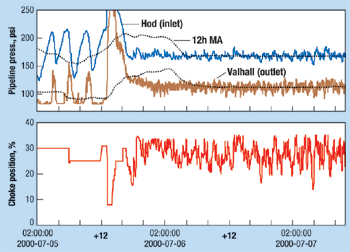Upstream control and optimization increases return on investment
Automation & ControlUpstream control and optimization increases return on investmentApplication of three control systems shows how unstable flowing wells, slugging in pipelines and unwanted production changes can be constantly monitored and corrected to optimize well productivity and recoveriesBjorn Bjune, Havard Moe and Morten Dalsmo, ABB Norway Described here with example applications are three advanced control / optimization solutions for the upstream industry, part of a comprehensive suite of systems and solutions for increasing oil/gas production. Applications are overviewed for: 1) stabilizing unstable wells, 2) stabilizing slugging in pipelines; and 3) monitoring well production. The bottom line is increased well production and the opportunity for higher oil/gas recoveries from the reservoir. Compared with other process industries, the upstream oil/gas sector has historically been considered "low-tech," mainly because of its low level of automation. However, products are available today that signal the start of a new era. Developed to recover more oil and gas, as well as achieve more consistent flow and throughput, they are at the forefront of a shift in the upstream industry to a higher level of automation that is fast becoming the standard rather than the exception. ABB has developed advanced control / optimization solutions for the upstream industry using its customers' field development and operational challenges as the starting point. Emphasis has been on flow assurance, accurate monitoring, and optimization of oil/gas flow networks. This work has resulted in the Optimizeit Active Well Control* and Optimizeit Active Flowline Control*, for stabilizing slugging wells and slugging pipelines. Both products improve regularity and throughput. Another product is the Optimizeit Well Monitoring System*, which provides data on the individual flows of gas, oil and water from production wells without having to install expensive multiphase flowmeters. These products should contribute to the next shift in automation level, in which the upstream moves from simple control schemes to advanced control products and algorithms. Stabilizing Unstable Wells Oil wells with long horizontal bores, and also gas-lift wells, tend to behave erratically under certain operating conditions. Unstable production has many drawbacks. For example, surge hinders smooth operation and calls for safety measures and means of guarding against shutdown. Also, total oil/gas production must be within the system’s design capacity, to provide adequate safety margins. Instability can sharply reduce lift-gas efficiency, while difficulties with gas-lift allocation computation are also common. And well instabilities make it impossible to distribute the lift gas optimally. All in all, unstable wells are difficult to operate efficiently. Active Well Control (AWC) technology is a unique, model-based feedback control solution for stabilizing unstable production wells. Wells with natural flow are stabilized by automatic actuation of the production choke – with gas-lifted wells, the gas injection choke may also be controlled. AWC holds the well automatically at its optimum operating point and assures stable flow, i.e., there is no slugging. Cyclic tubing and casing heading in gas-lift wells are also eliminated. More oil is produced since pressure fluctuations and oscillating flows are eliminated. Typically, AWC uses pressure / temperature data from production tubing, but for gas-lifted wells, data taken from the annulus may also be used , Fig. 1. Pressures in the production tubing may be measured anywhere between the bottom of the well and the wellhead. The pressure downstream of the production choke may also be used.1
AWC is currently undergoing extensive field tests. So far, these have validated the well-flow stabilization action and shown an increase in production. Also, an extensive simulation program has confirmed performance of the solution over a wide range of well conditions. Fig. 2 shows simulation results for a vertical gas-lift well, when wellhead pressure is used to manipulate the gas injection choke. The two diagrams, A and B, show the dramatic change in wellhead pressure and oil production rate when the well controller takes over. Similar results are obtained using casing pressure for active control of the production choke. Fig. 3 further shows stabilization of downhole pressure in a horizontal well, where pressure is measured and used for automatic control of the production choke.
Stabilizing Slugging Pipelines Multiphase pipelines connecting remote wellhead platforms and subsea wells are an increasingly common feature of offshore oil production. More than 2,000 lines of this kind exist worldwide, with another 2,000 scheduled to be added over the next five years. In addition, long-distance lines are likely to be used in the future to connect subsea processing units directly to onshore processing plants. One of the biggest challenges confronting operators of offshore processing plants and subsea separation units is how to control disturbances in the feed to the operation process, i.e., how to smooth or avoid flow variation at the outlet of multiphase pipelines that connect wells and remote installations to the processing unit. One common form of flow variation is slug flow, in which liquid flows intermittently in pipes in a concentrated mass, or slug. Such unstable behavior in multiphase pipelines adversely affects operation of offshore production facilities. Severe slugging can even cause platform trips and plant shutdown. Frequently, compressors trip due to large, rapid variations in feed rates to separators caused by unstable fluid flows. Much effort has gone into avoiding operational problems associated with severe slugging. The two main approaches are: 1) design the system in a way that avoids the problems; and 2) find ways to tolerate the unwanted behavior, e.g., through operational changes or control. Each approach is usually very costly since, in modern field developments, operating conditions vary widely and can be hard to cope with, without multiple production lines and parallel processing. Active Flowline Control (AFC), introduces a third approach: avoid problems by using appropriate instrumentation and control. AFC is a feedback control solution for stabilizing terrain-induced slug flow in multiphase pipelines. By removing slug flow, severe process facility upsets are avoided, which improves process flow regularity. Installing AFC is several orders of magnitude cheaper than slug catchers. Field-tested and confirmed fit-for-purpose, it is being used in several offshore fields in the North Sea. Tests and first installations alike have provided good results for pipeline flow stabilization. The core of the system is the feedback control algorithm, for which patents are pending. Fig. 4 shows how the system uses pressure / temperature measurements at the pipeline inlet and outlet to adjust the choke valve. If line flow measurements are also available, these can be used to adjust the nominal operating point and tuning parameters of the controller.
It has been shown that installing AFC on production pipelines increases oil/gas production. After installation on the Tor-Ekofisk pipeline, it is estimated that oil and gas production increased by about 10% and 5%, respectively. The system also improves separation in the customer’s inlet separator and reduces cost of compressor operation by lowering energy consumption and reducing wear. Varying flowrates and the cyclic operation of the Hod platform wells made it difficult to conclusively determine whether the wells produced less, more or about the same as before the slug controller was installed. However, the experience showed that the wells could be keep in operation longer, thereby indirectly increasing production by increasing the time onstream. This was particularly true for Well H8, which was in continuous operation for as long as two weeks with the slug controller in operation, compared to only a few days onstream, typically, without the slug controller. Fig. 5 shows results from the Hod-Valhall pipeline operating without active control, left, with characteristic pressure oscillations for terrain-induced slug flow, then the same line with AFC in action. The controller stabilizes the pipeline, and mean pipeline pressure drop decreases as soon as the slug cycles are eliminated.
Teamwork makes the difference. ACF is the result of multidisciplinary research in the fields of fluid mechanics and cybernetics, but builds on earlier theoretical and practical work. 2 – 4 Recently, several papers show the feasibility and potential of applying feedback control techniques to unstable multiphase flow (see paper SPE 71540 for an overview).5 However, to ABB’s knowledge, there are only four installations in operation which have stabilizing controllers installed. These are the Dunbar-Alwyn pipeline,6 the Hod-Valhall pipeline,7 the Heidrun-Nordflanken tie-in pipelines and the Tor-Ekofisk pipeline. One reason for this might be that cybernetics and fluid dynamics are usually treated as separate technical fields, i.e., the control engineers have limited knowledge of multiphase flow; and the fluid dynamics experts have limited insights into what can be achieved with feedback control. Monitoring Well Production/ Application Areas The Well Monitoring System (WMS) provides real-time estimations of flowrates of oil, gas and water from all individual wells in an oil field, based on data from sensors in wells and flowlines. The model-based system may be used as a software multiphase flowmeter, a reliability tool, or a production allocation system. The WMS simulates all the flows in the production system simultaneously, using every available data point. This fieldwide approach guarantees maximum accuracy and offers redundancy, making the system independent of individual sensors – therefore more reliable and robust. All calculations performed by the system are based on a mechanistic model for multiphase flow, and a full, compositional model of the fluid (PVT model). Using the model to calculate all fluid properties ensures that analysis of blended fluids from different zones in the reservoir is just as accurate as the simulation of a single fluid from a single well. This approach improves on the most commonly used method based on interpolation of tabulated data. In one of three application areas described below, for daily operations, the WMS may be thought of as a distributed software multiphase flowmeter. It estimates the flowrate of oil, gas and water, based on data from standard well instrumentation and handles every configuration of well instrumentation. In addition, it detects instant changes, such as water and gas breakthrough, in the composition downhole. By performing these functions, it provides the basis for automatic well control or choke setting optimization. Reliability tool. Where equipment might fail, or when redundancy is needed for other reasons, the WMS can be used as a reliability tool for the installed instrumentation. By validating specific measurements, it introduces redundancy to the system. Measured data is estimated whenever the measuring equipment fails, reducing unscheduled maintenance and increasing uptime. And as a production allocation system, the WMS can be used with every well configuration and directs production from the field to the various zones in the reservoirs. Thus, it provides input for the reservoir simulation and improves reservoir management. The system provides a basis for production optimization and allows a higher reservoir recovery factor. It is important to note that Active Well Control, Active Flowline Control and the Well Monitoring System are not general-purpose information and control technologies, but tailor-made products. The Intelligent Oil Field The vision that drives the developer’s program to produce advanced control and optimization technologies for multiphase flow is that of the intelligent oil field. Such a field features enhanced production based on a sound knowledge of the reservoir behavior, the wells, the gathering systems and the production systems. New technologies for reliable sensing under and over the mud line are an important prerequisite for such a field. However, efficient utilization of all this extra information depends on information technology being used for active control and online optimization. Through use of various technologies, the industry has already managed to increase recovery to 30 to 60% today, from 10 to 20% in the early 1970s. It is ABB’s belief that, by using active control and optimization technologies, this recovery factor can be improved still further – results obtained so far point clearly in this direction. Literature Cited 1 Jansen, B, et al., "Automatic control of unstable gas lifted wells," paper SPE 56832, presented at the 1999 Annual Technical Conference & Exhibition, Houston, Texas, Oct. 3 – 6, 1999. |
||||||||||||||||||||||
- What's new in production (February 2024)
- U.S. operators reduce activity as crude prices plunge (February 2024)
- U.S. producing gas wells increase despite low prices (February 2024)
- U.S. oil and natural gas production hits record highs (February 2024)
- Dallas Fed: E&P activity essentially unchanged; optimism wanes as uncertainty jumps (January 2024)
- Enhancing preparedness: The critical role of well control system surveys (December 2023)

